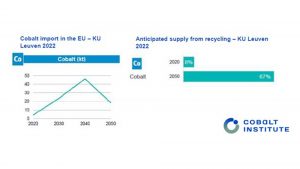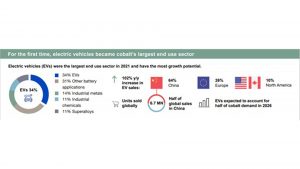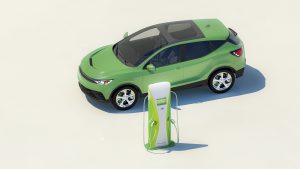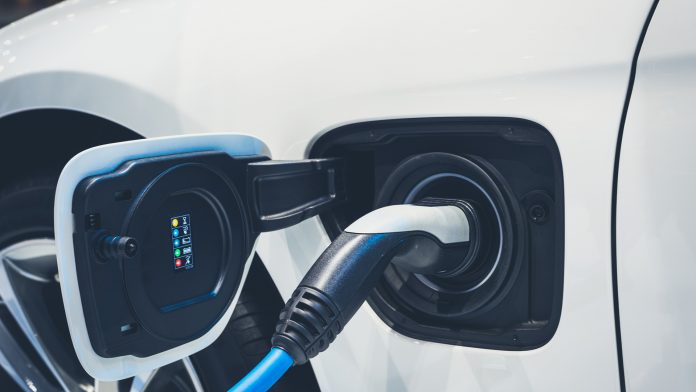The Cobalt Institute showcases the metal’s essential role in developing future green technologies.
Governments and organisations around the world invest in green technologies, aiming to become carbon neutral in the most efficient way. Electric mobility is part of the solution to tackling climate change and building a green economy. Cobalt is a raw material that is essential for modern, high-performing batteries, and therefore, uptake of electric vehicles (EVs).
The demand for cobalt is expected to increase up to 403% in 2050.1 In 2021, for the first time, EV batteries became the largest single use for cobalt (34%), followed by the demand for other battery uses like phones and laptops (31%), industrial metals (14%), and industrial chemicals (11%).2
Cobalt-containing battery chemistries accounted for 74% of the global EV battery market
Cobalt-containing EV batteries are a technology of choice for many car manufacturers, largely due to their superior performance and recyclability. The majority of modern EVs use either lithium-nickel-manganese-cobalt-oxide (NMC), nickel-manganese-cobalt-aluminium (NMCA), or lithium nickel-cobalt-aluminium (NCA) batteries. In 2021, cobalt-containing batteries accounted for three-quarters of the global EV battery market.2 The demand for EV batteries is expected to grow and EVs are expected to drive 70% of medium-term market growth.2
Cobalt is also infinitely recyclable which makes it one of the critical materials for a circular future. Currently, around 8% of cobalt is anticipated to come from recycling.1 As the EV battery market grows, and recycled cobalt will increasingly cover the existing demand, 67% of battery cobalt in the EU could come from recycled sources in 2050.1 Therefore, new recycling capacities are needed to match the market. Recycling cobalt contributes to a smart and circular world, in which the environmental footprint of the production of goods is minimised.
EVs become the major driving force for cobalt demand growth in 2021
Cobalt demand continues to grow. The Cobalt Institute’s Cobalt Market Report found that in 2021, the cobalt market showed an unprecedented demand increase of 22%, and, looking ahead, the demand is forecast to approach 320 kt in the next five years from 175 kt in 2021.2 The EV market will greatly influence the growth in the given years, and by 2026, EVs will account for half of the cobalt demand. This development, and the fact that in 2021 EV batteries became the largest single use for cobalt (34%),2 highlights that more car manufacturers are investing in cobalt-containing EV batteries to be prepared for the green transition.
Cobalt is produced as a by-product from large-scale copper and nickel mines. Currently, cobalt is mainly sourced in the Democratic Republic of the Congo (DRC) where 74% of it is mined.2 The DRC produced around 118 kt in 2021, and Australia is the next largest producer with 5.6 kt last year. Other important countries for cobalt sourcing are Cuba, Russia, the Philippines, and Canada, each producing around 3-5 kt in 2021. With rising supply expected from countries such as Indonesia, the US, New Caledonia, and Canada, the DRC will lose a small amount of global share in the coming years, albeit remaining at above 60%.2

After cobalt is sourced and processed, refining is needed for most applications, including EV batteries. The refined cobalt metal can be used directly for a variety of applications or converted into other cobalt compounds (e.g., cobalt salts and oxides) that are used in numerous applications. Primary refined supply, including both metal and chemical products, grew by 17.9 kt in 2021 to 144 kt. Most of the refining takes place in China with around 72% of the total primary production (104 kt in 2021). Finland is the second largest refiner with 14 kt or 10% of the supply.2

Artisanal mining needs formalisation for a sustainable and green transition
While the vast majority (80-90%) of DRC cobalt comes from large-scale miners operating responsibly with salaried employees in formalised conditions,2 there is an artisanal mining sector that has created humanitarian concerns. It is important to formalise artisanal mining in order to end poor practices while allowing people a source of living, as artisanal mining is a lifeline for many families who depend on it to pay for food and education.
The DRC is already taking action to formalise the sector and allow it to continue playing a role in alleviating poverty in safe, formalised conditions that exclude illegal practices like forced and child labour. In March 2021, the Entreprise Générale du Cobalt (the EGC), mandated by the Democratic Republic of Congo Government, released a new ‘Responsible Sourcing Standard’ document which outlined their planned formalisation of the ASM sector in the DRC.
The cobalt industry is determined to work with the DRC to make sure cobalt is produced responsibly. The projects and initiatives like the Global Battery Alliance, Responsible Minerals Initiative, the Fair Cobalt Alliance, and others, all aim to put artisanal mining in the DRC on a legitimate footing. The Global Battery Alliance is, for example, helping to establish a sustainable battery value chain and the Fair Cobalt Alliance (FCA) is working on the ground to transform artisanal mining into a driver of development. Together with all those initiatives, the Cobalt Institute aims to improve responsible cobalt mining in the DRC.
Cobalt is essential for green technologies
While 34% of cobalt is used for EV batteries,2 its application is not limited to those. Cobalt is also needed for other green technologies, such as wind turbines.
Cobalt is also used in wind power, which is one of the fastest growing sources of renewable energy and could generate 35% of global electricity production by 2050.3 To create electricity, the generator is dependent on a magnetic field. Permanent magnets in the generator create the magnetic field without any input of electricity, allowing the turbines to run at lower wind speeds while still producing energy. As an important component of the strongest permanent magnets, cobalt is used as an element for renewable wind power.
Moreover, cobalt is applied in catalysts for the oil refining sector to remove impurities in crude oil to reduce vehicle emissions and sulphur in maritime emissions. Not related to the green transition but equally important is that cobalt is also part of vitamin B12, making it important for human health and animal feed. It is also used in medical devices, high-performance tools for machining of metal parts, and superalloys in machines like jet turbines, where high-temperature strength is important.
Co-operation from the private and public sectors is needed for a resilient cobalt supply chain and zero emission mobility
Cobalt is essential to tackle climate change as it is needed for EV batteries and other green technologies. Given this, the demand for cobalt will grow in the coming years. But when it comes to the short and medium term, the demand for cobalt will rely on primary cobalt which is mainly sourced in the DRC. Efforts need to be made from governments but also from industries to ensure that the supply chains are sustainable, resilient, and transparent, not only with regard to the sourcing but also with the upcoming recycling aspect as new a recycling capacity needs to be provided here.

About the Cobalt Institute
The Cobalt Institute is the global trade association of the cobalt industry representing the interests of cobalt producers, users, recyclers, and traders. This includes around 75% of the cobalt value chain. The Cobalt Institute is promoting the responsible and sustainable production and use of cobalt in all its forms and applications.
References
- KU Leuven/ Eurometaux study: Metals for Clean Energy: metals-for-clean-energy.pdf (eurometaux.eu): In comparison to today’s cobalt demand
- Cobalt Institute – Cobalt Market Report: Cobalt Market Report 2021 – Cobalt Institute
- Cobalt Institute- Wind Power: https://www.cobaltinstitute.org/essential-cobalt-2/powering-the-green-economy/renewable-energy/
The Cobalt Institute
https://www.cobaltinstitute.org/
https://www.linkedin.com/company/cobalt-institute/
https://twitter.com/cobaltinstitut
Please note, this article will also appear in the eleventh edition of our quarterly publication.






